| ||||||||||||||||||||||||||||||||||||||||||||||||||||||||||||||||||||||||||||||||||||||||||||||||||||||||||||||||||||||||||||||||||||||||||||||||||||||||||||||||||||||||||||||||||||||||||||
Your January 2006, YouCanDraw.com Communiqué
||||||||||||||||||||||||||||||||||||||||||||||||||||||||||||||||||||||||||||||||||||||||||||||||||||||||||||||||||||||||||||||||||||||||||||||||||||||||||||||||||||||||||||||||||||||||||||
Caricature and Drawing Newsletter for January, 2006
This newsletter is reproduced here by courtesy of YouCanDraw.com -
Once and for all getting you drawing faces and caricatures:
January, 2006
Back to the Archives
(for members)
First questions - from general to specific to the absurd...
First, where does the nose sit? What's around it? In what is it embedded? ( A bunch of trouble?) What do you look for when drawing a nose? Is it really there to support the glasses? Rudder your way through life? Thumb at things? Do you really have to pay through the nose? Yes it's multitalented and multitasking.
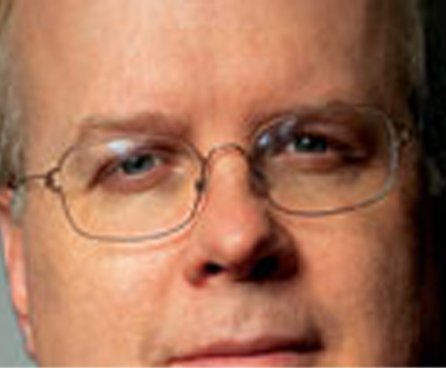
Let's get to it...the where of the nose
We covered Karl's eyes in the December issue and I mention that because it's important to put the nose in a context: where does the nose sit in relation to the eyes? First, it's generally a given fact that the eyes are about one eye-width apart. True, it doesn't look that way, but when you get out your rulers, it's actually a good rule of thumb.
Why does this space (the one between the eyes), look less than that? I think it's because there isn't a single flat plane, or a single color or a consistent light or shadow area between the eyes. You also get fixed on the relative narrowness of the nose; plus you have all the different contours of the nose going on in there. It breaks up this space into sections: you have the side of the nose in shadow on one side, then you have the spine of the nose where it's in a plane parallel to the rest of the face, then it rolls back down to the side of the face that might be bathed again in light. There's topography going on there. In a word, the space between the eyes is filled by the nose and the transition of going from eye, to nose, and back to eye again.
And all of it can be described in terms of lines, edges, angles, shapes,. proportion, light and shadow. All of it. Every part of it. Cool! We've now established that. Again :-)
The scope of the nose
As long as we're going left to right (or right to left), lets drop down to the next horizontal section of the face. (The next horizontal section meaning like at the level of the cheek bones - we started at the level of right-between-the-eyes above.) As you do this you run across the same topography as you move side to side: the nose is popping up and out again. Okay, quick review. The nose is bounded by the forehead above, by the eyes to the left and right higher up on the face, the cheeks a little further down. At the lowest part of the nose, it's bounded by the apron of the upper lip. Squint your eyes and you'll see the way light and dark (i.e. shadow and light), lines, edges, fits together like a jigsaw puzzle - all that stuff I've gone on about to ridiculous levels in the book. Not super clear? Keep reading.
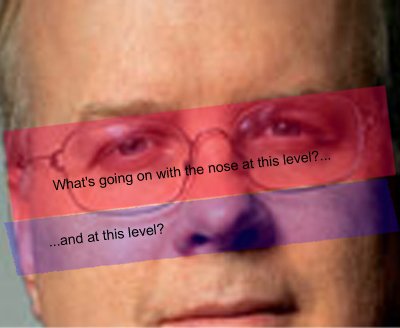
Looking at what's going on with the nose at different horizontal levels...even if our
horizontal boxes aren't horizontal...at the level of the eyes, then at the level of the
cheekbones
(The original question was "What's caricaturable about Mr. Rove's nose?" We're going to take a slightly different route in determining this today. Hang with me...)
So what's notable about his nose?
Well, first of all, it's small compared to the way it fills out that space between eyes and the mouth. If you draw a line between the eyes and a line across the face at the level of the mouth and you did the same with say, Pete Townsend, it becomes obvious whose nose is proportionality larger:
| 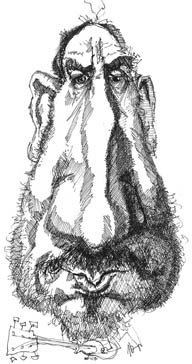
Senor Pedro Townsend
|
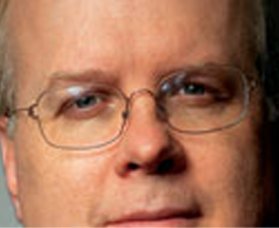
Compare these two gentlemen. Ask yourself this: "In which is the bottom of the nose closer to the level of the eyes? In which is the bottom of the nose closer to the line made where the upper and lower lips touch?"
How does the width of Mr. Rove's nose compare to say Jazz great Thelonius Monk? Check out this next caricature...and why is Mr. Monk giving Mr. Rove such a look of discernment?
|
|

The Audacious Karl Rove
|
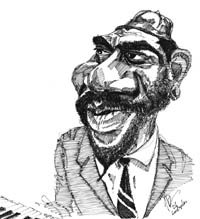
Mr. Thelonius Monk
|
I mentioned this above, now I'll show you - long as we're hinting at proportions. A good way to visualize proportions of the nose in relation to the rest of the face is this: imagine again a line drawn through the middle of the eyes, under the bottom of the nose (the base of the nose), and horizontally through center of the mouth (i.e. where the lips touch). Imagine all the lines parallel, like this:
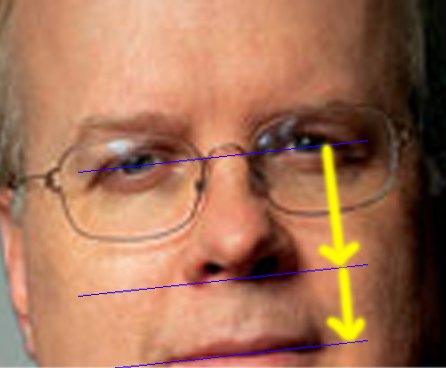
Imagining horizontal lines drawn through the three major features of the face
The yellow lines are there to demonstrate the approximate distance between these three landmarks (want to see a whole ton more about the horizontal landmarks of the face? See the free Janet Jackson Flash lesson, and this section in the Ani Difranco in-depth lesson) .
Now scroll back up to the picture of Mr. Townsend and imagine the same three lines drawn on his face. Which line is the bottom of the nose closer to: the line drawn through the middle of the eyes or closer to the line drawn between the lips? If you were doing a Laurel and Hardy type double caricature (that is two faces drawn in the same picture) does it become obvious how you could play the exaggerations of each off each other? Of course, if you don't have a Pete Townsend in every picture to play your subject off against, you need some kind of internalized or benchmarked standard of comparison. Mr. Average is that guy until you start getting a feel for judging subtle differences in anatomy.
Alright. So far we've very quickly discussed some of the anatomy surrounding the nose and we've talked a little about drawing / visualizing horizontal lines as an aid to help you visualize proportions between the eyes. Now, right quick, we'll look at the anatomy of Sir Karl's nose itself.
The gist of this: Karl Rove's actual nose
Super quick: let's review the three parts of the nose. In a side view you can divide up the nose into three wedges: the first or top wedge, the middle or second wedge and the base of the nose - which includes the bulbous tip, the nostrils and the nares (the nares being the tissue surrounding and being the nostrils). And this ain't just idle fluff: those three wedges are actually based on the underlying anatomy of bone and cartilage) Here's an illustration:
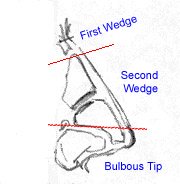
The three wedges of the nose
Here's a somewhat abstracted 3/4 view with the nose against it's background anatomy. Can you point out the three wedges of the nose?:
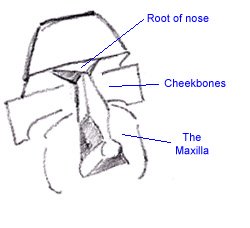
Three-quarter view of the nose against it's
background bony anatomy
In this next photo, I've outlined in yellow (my mouse was sticking like crazy as I drew this in Photoshop) the wedges in Mr. Rove's nose. Look at this picture and the others above until you're convinced you can see the different parts of the anatomy. [Also check out the pages at this site on the nose or if you want the full, triple-deep coverage, in-depth from superficial to complete shadow-and highlight-recognition of the nose, see the full work-up in your e-sourcebook: "Noses". ]
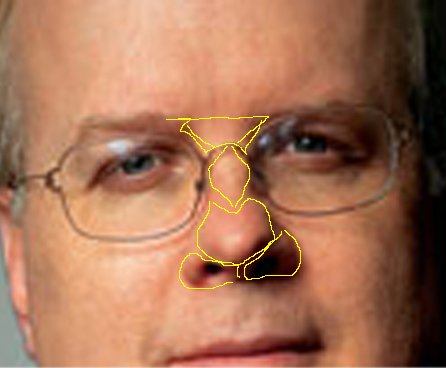
A rough outline of the main anatomical sections of Mr. Roves nose - squint and see if you
can't perceive the overall shape of Mr. Rove's nose
(I know I said the nose is made of three wedges above: I group the bulbous tip and the nostrils together in the "bulbous tip" part of the three wedges. Seeing this more complicated set of anatomy [the tip and the nostrils] as a single shape at the base of the nose makes it easier to see as a unit. We can always split hairs later. And "splitting hairs" while you're drawing, i.e. really learning to see the fine differences in all those things we've talked about and keep talking about - like lines, edges, shapes, angles, proportions, highlights and shadows - these are at the core of making you a better observer.)
Shadowy Karl
Now to the nitty gritty. I'm not going to point out the wedges of the nose i.e. the specific anatomy again, but I still want you to look for these shapes within the nose as we look at the nose in terms of highlight and shadow shapes.
The root of the nose (where the nose arises out of the forehead), which is also the first wedge is thick, somewhat broad. It fits together with the middle wedge of the nose about where the bridge of the glasses are. The bottom of the bulbous tip doesn't come down a whole bunch farther than the bottom rim of the glasses, and the nostrils / base of the nose are distinctly separate from the bulbous tip.
Speaking of the bulbous tip, the shape of the highlight and shadows suggest a rather delicate shadow dividing the very tip of the nose in half:
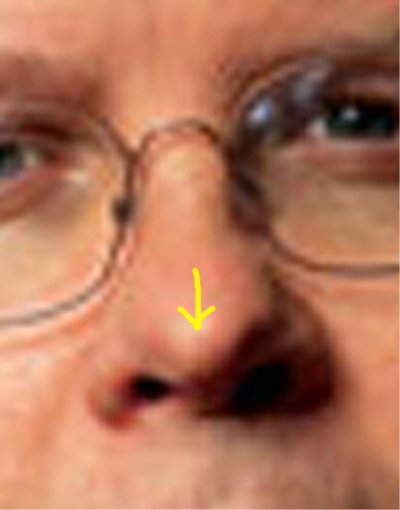
Squint and see if you can't make out the fine line there that divides the very tip of the
nose into left and right halves -- it's subtle -- and it's just beneath the yellow arrow
This next photo displays a rough outline of the highlights, the brightest light spots on the nose. They're outlined in yellow. Ask yourself what information the highlights give you about the shape of the nose. Don't think too hard, just try to see the highlights as part of a larger jigsaw puzzle of the various shapes that make up the map of the nose (you may have to scroll up to see the highlights better...sometimes the yellow outlining makes them harder to make out...but I'll bet you'll see them now when you do look again):
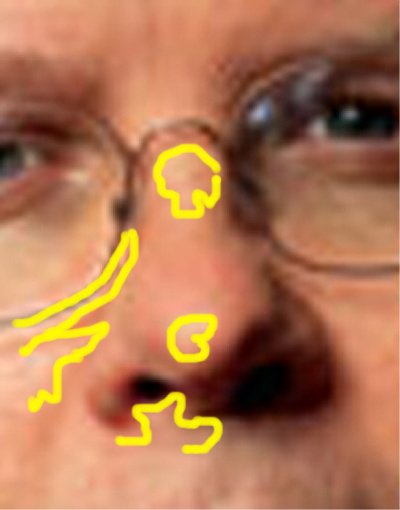
The brightest highlights
Next illustration: the medium tone shadows. These are shadows that aren't real, real dark. They're in-between, that's all, that's what makes them medium. They also help your brain perceive in three dimensions what's actually in two dimensions on your computer screen. Compare this illustration with the one above. Make sure you convince yourself of the distinctness of each shape:
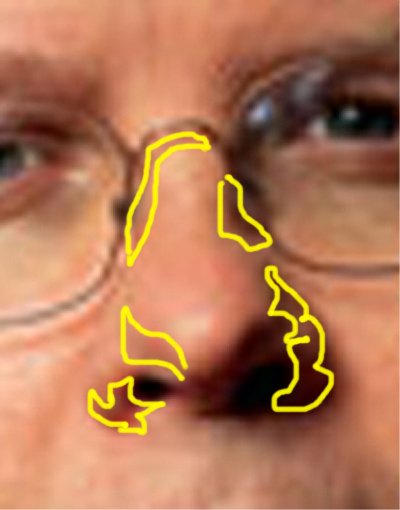
Middle tone shadows
And now, on to the darkest shadows. I've outlined them again in Photoshop. Scroll between all these pictures until you can look back at an un-outlined photo of Karl and and see these different areas of tone (which represent shape) for yourself.
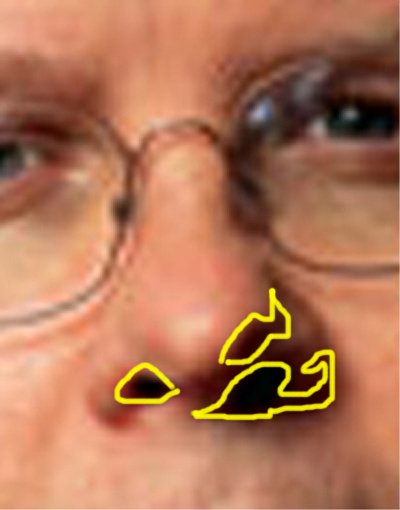
Outlining the darkest shadows of Mr. Roves nose
Just for fun, check this out too: the shadows to each side of the very tip tend to suggest a rather pointy tip of the nose:
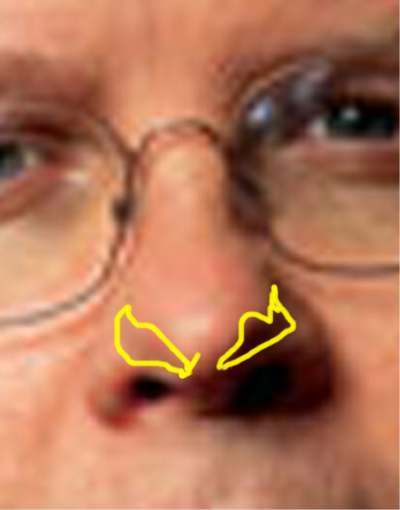
Shadows that help define the bulbous tip
Lastly here, I've taken the same photo and I've run it through the "Cutout" function in Adobe Photoshop. The Cutout function groups similar areas of light, shadow, and color into rough groups. It doesn't get hung up on deciphering every teeny tiny color or light change. Yes, learning to perceive all those minute changes makes you a better artist, but it's also an extremely valuable skill to be able to shift to see things in broader groupings. Squinting throws out a lot of the detail and allows you to see areas of light and shadow as more general shapes. See how this illustration compares with the others above - and try squinting while you view the other pictures above and see if you don't see light and shadow shapes that look a lot like this:
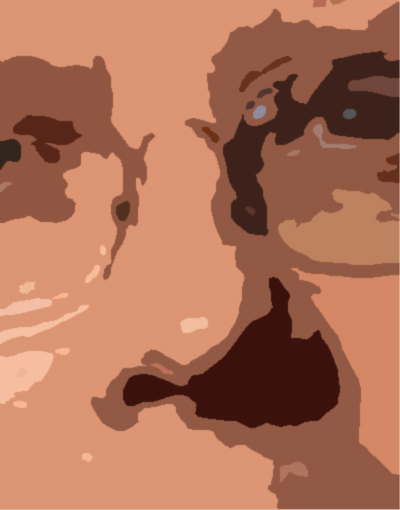
The Photoshop "Cutout" version of light and shadow on Karl's nose
Ok, I've thrown a lot at you here. Gotten pretty tedious actually. You really need a pretty good understanding of all the fundamentals of drawing to make today's lesson make sense. (Course, you can find all the fundamentals in the sourcebook :-).
If it made sense, awesome. If it did not, here's the challenge: to caricature (or draw realistically), anyone's nose, you've got to learn to see it (or any part of anatomy) in terms of lines, edges, shapes, relationships, perspective/proportion, light, and shadow. That's it. That's everything. I'm a broken record about this.
But if you can make even limited sense of those things I just mentioned and learn to see each each section of the nose as representable on paper in those terms, then you can manipulate each part of the nose (and Karl Rove's nose in particular today), because you see each part as pieces of a larger jigsaw puzzle, you understand it.
Look again how I drew Karl's nose in these caricatures (and yes, I've been getting extra mileage out of these couple of caricatures :-):
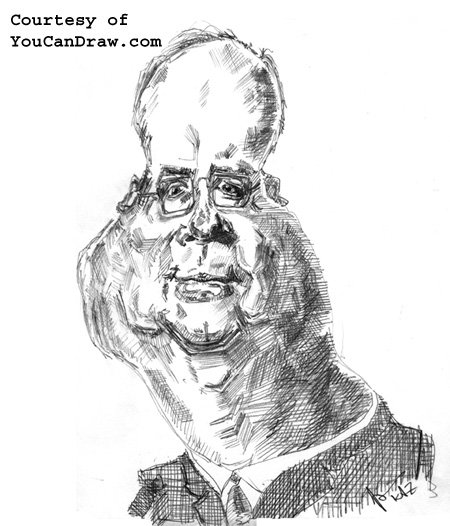
Here's a close up of the nose and eyes (from the original pencil sketch of the picture above). Look very closely at the different shadow and highlight shapes. Pick one particular shape as you do this and compare it with the photos above. Take for instance the left nostril shadow. Look how closely it resembles the shape of the shadow in the photo -- yet this is still a caricature. See how closely related realism and caricature actually are? Prove it to yourself :-) :
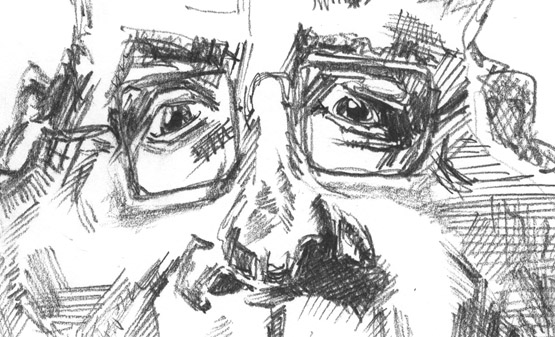
Heck, I'll put a copy right here for you:

And this last one (note here how the eyes and nose relate to the rest of the face in terms of overall size, proportion, and depth of shadow. Do the same for the caricature of Karl just above):
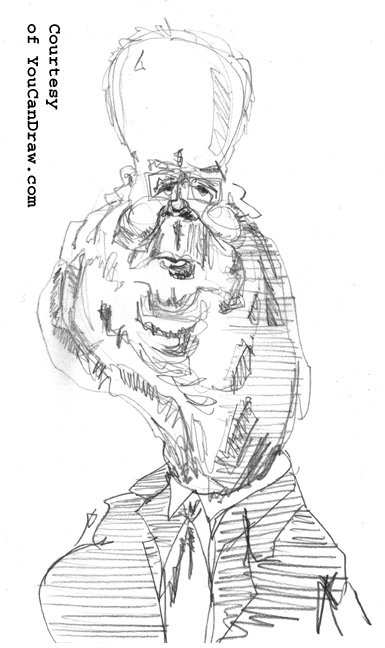
Next month I think we'll leave the nitty gritty alone and do a fresh carciature before we return to more specific details of Mr. Rove. Coo-el!
Sos keep your nose clean and keep on drawing :-)
Warmly,
Jeff
Kasbohm & Company's
Drawing-Faces-and-Caricatures-Made-Easy.com
and
YouCanDraw.com
© Copyright, All rights reserved 1997-2006
|